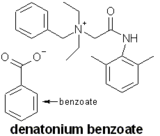Denatonium benzoate: Difference between revisions
Uncle Jesse (talk | contribs) (Creating page) |
m (added image) |
||
| Line 1: | Line 1: | ||
[[File:Denatonium benzoate.png|thumb|160px|right|Denatonium benzoate]] | |||
Denatonium benzoate, also called Benzenemethanaminium and Benzyl diethyl ((2,6-xylylcarbamoyl)methyl) ammonium benzoate, is the bitterest compound known. Discovered in 1958, it also has the tradename "Bitrex" (a trademark of UK company Macfarlan Smith). As little as ten parts per million make substances unbearably bitter to most humans. Denatonium benzoate is a white, odourless solid that is used as an aversive agent, i.e. an additive that prevents accidental ingestion of a toxic substance by humans, particularly children, and by animals. | Denatonium benzoate, also called Benzenemethanaminium and Benzyl diethyl ((2,6-xylylcarbamoyl)methyl) ammonium benzoate, is the bitterest compound known. Discovered in 1958, it also has the tradename "Bitrex" (a trademark of UK company Macfarlan Smith). As little as ten parts per million make substances unbearably bitter to most humans. Denatonium benzoate is a white, odourless solid that is used as an aversive agent, i.e. an additive that prevents accidental ingestion of a toxic substance by humans, particularly children, and by animals. | ||
Structure and physical properties | Structure and physical properties | ||
Revision as of 08:42, 26 September 2017
Denatonium benzoate, also called Benzenemethanaminium and Benzyl diethyl ((2,6-xylylcarbamoyl)methyl) ammonium benzoate, is the bitterest compound known. Discovered in 1958, it also has the tradename "Bitrex" (a trademark of UK company Macfarlan Smith). As little as ten parts per million make substances unbearably bitter to most humans. Denatonium benzoate is a white, odourless solid that is used as an aversive agent, i.e. an additive that prevents accidental ingestion of a toxic substance by humans, particularly children, and by animals. Structure and physical properties
Image:Denatonium_benzoate.png
The compound consists of benzoate (that is, the conjugate base of benzoic acid) and an ester of two PABA molecules. Its structure is related to lidocaine, differing only by the addition of a benzene and benzoate ion in solution. It's also similar in structure to other anesthetics like novocaine and cocaine. Indeed, it was discovered during anesthetic research.
Denatonium benzoate, a white crystalline powder like many organic compounds, is not known to pose any long-term health risks although exposure may be irritating. No world health agencies list it as a carcinogen. It does, however, cause a very bitter taste in humans and most animals at concentrations in the parts per million range.
- Molecular mass: 446.58
- Melting point: 166-170°C
- CAS number: 3734-33-6
- Chemical formula: C21H29N2O . C7H5O2
Applications
The bitterness of the compound guides most applications of denatonium benzoate. Denatonium benzoate is used to denature ethanol so that it's not taxed as an alcoholic beverage. One designation in particular, SD-40, indicates that ethanol has been denatured using denatonium benzoate. In fact, the common name for this chemical, denatonium benzoate alludes to this application.
Denatonium benzoate also discourages consumption of harmful alcohols like methyl alcohol and isopropyl alcohol. Denatonium benzoate is therefore often used in rubbing alcohol as a non-active ingredient. It's also added to all kinds of harmful liquids including solvents, paints, varnishes, toiletries, and other household products.
Since 1995 when Oregon required that it be added to antifreeze and windshield wiper fluid, the compound has been increasingly found in these substances throughout the world. The addition of denatonium benzoate is credited with saving children and animals who might otherwise drink sweet-smelling antifreeze or wiper fluid and get ethylene glycol or methanol poisoning respectively.
Other uses include nail polish for preventing nail biting, and as animal repellent (especially for big game like deer).
It should be noted that animals are known to have different sensitivities to the effects of Bitrex. It has been used to safeguard rat poisons, so presumably rats are not deterred by it, although there is evidence that a small percentage of rodents do avoid it. Some cats have been known to disturb such baits - it may not be as effective a deterrent for them as it is for humans, or perhaps some cats are not deterred due to a genetic factor similar to that affecting human perceptions of the taste of phenylthiocarbamide.
